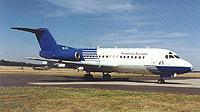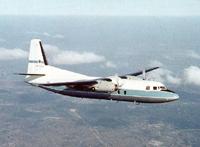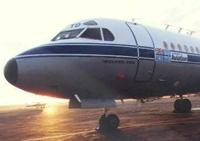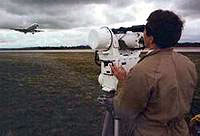by Roger Meyer

This brief history concentrates on the flight testing of navigation aids rather than the fleet of about thirty types of aircraft which the Department has owned for this and other purposes, or the training of pilots, inspection of aerodromes and air routes, search and rescue, post-accident investigations or the carriage of VIPs. It is of historical interest, however, to note that one of the Department's first aircraft, a DH-50 (registered G-AUAB) made the first round Australia landplane flight in 1924.
Flight calibration of navigation aids essentially comprises three elements: a specially equipped aircraft to fly along the radio course in space radiated by the beacon (e.g. the instrument landing system); a ground measuring device which can accurately plot the aircraft’s flight path; and a precision laboratory where the equipment can be accurately calibrated.
The flight calibration of radio and electrical navigation aids has been a function of the Department and its predecessors since 1937. The first radio navigation aid was the 33MHz ‘Lorenz’ Radio Range, ten of which were installed in 1936-1938 but could not be used operationally until they had been flight-tested. The Civil Aviation Board (CAB) wanted to buy a Lockheed for this purpose, but was compelled by the government to "buy British". In the meantime, a direct result of the inquiry into the crash of the Douglas DC-2 Kyeema which struck Mount Dandenong on 25 October 1938 was a Government instruction for the Civil Aviation Board to calibrate the Lorenz radio ranges and a Guinea Airways Lockheed 10A (VH-AAU) was hired to flight test the beacons.

In 1946, the Department of Civil Aviation (DCA) acquired two war-surplus Douglas C47 transport aircraft, registered VH-DMV and VH-ASD (later re-registered as VH-CAO and VH-CAN) for the purpose of flight testing radio navigation aids. On delivery from Manila they were fitted out with special radio equipment by Butler Air Transport in Sydney so that they could flight test the Visual Aural Range (VAR) which superseded the Lorenz beacon, Localizers (the Glide Path came later), Non-Directional Beacons (NDBs, then called ‘Homers’) and, later, Distance Measuring Equipment (DME).

In 1955 the Flight Test Section was formed as a Division of the Airways Planning and Investigations Branch. It was initially under the control of Stan Joyner and Max Cassidy. Max Crisp was in charge of the Flight Inspectors (technicians), who were located in the DCA laboratory near the Maribrynong Munitions Works, with the DCA pilots based in DCA headquarters at Henty House and the aircraft located at Essendon Airport.

Sites had to be selected for beacons, and the whole airways system had to
be regularly inspected to ensure that it met the stringent requirements of ICAO
Annexe 10.
In 1959, the Director General of Civil Aviation, Mr D.G. Anderson, CBE, directed Captain Frank Shannahan to establish the DCA Flying Unit, entirely based in Hangar 3 at Essendon Airport, and forming part of the Head Office Operations Branch. Frank was appointed Superintendent, and under him were five sections: Pilots; Flight Surveyors/Laboratory Technicians; Engineers/Draftsmen; Aircraft Maintenance; and Administration Support.


Two
aircraft surveyors, John Ayres and Rod Torrington worked in Holland between the
end of 1974 and April 1977 while the aircraft were modified and fitted out with
the technical equipment, including 37 antennae. By now the navigation aids tested
included full ILS, VOR, radar
and T-Visual Approach Slope Indicator System (T-VASIS).
The function of tracking the aircraft from the ground was for many years performed by two technicans - one operating a theodolite to track the aircraft, and the other relaying these bearings back to the aircraft via a portable VHF transmitter. There were drawbacks to this labour-intensive method, namely the requirement for good visibility and a high ceiling, and the costly delay while the technicians with the theodolite drove to a remote site.

There was nothing
suitable on the market, so DCA invented its own. The system was simple but very
effective, and DCA decided to patent it. Imagine their surprise to find that they
had reinvented, and improved on, the USA Trident nuclear missile guidance system!
Notable contributions made in this area were made by Brian O’Keeffe, Frank
Partridge and Keith Farmer. Several versions were produced, and Peter McNab recalls
a DC3 being tracked from a distance of 32 miles.

The Flying Unit was acknowledged to be a world class facility. Overseas visitors recognised the quality and value of the service it provided. This was attributable to a number of factors: the suitability and the fitting out of its flight calibration aircraft; the professionalism of its staff; and the quality of its research and development. It was this latter which contributed to the development of Distance Measuring Equipment in the 1950s, the T-Visual Approach Slope Indicator System (T-VASIS), the Microwave Landing System (Interscan), and (more recently) GPS.
At its zenith the Flying Unit had a staff of over 100, maintained 25 aircraft, and was responsible for 640 navigational aids. Fron the early 1960s, the Unit’s expertise extended beyond Australia and New Guinea to Fiji, Norfolk Island and Indonesia. In the 1990s it also serviced the Australian Defence Forces’ navigation aids and the airways systems in New Zealand, Vietnam, and the Philippines. Their patch covered one ninth of the earth’s surface area, which was a remarkable achievement.
Back to the main Flying Operations index
To the index of Departmental Aircraft
If
this page appears without menu bars at top and left, click
here